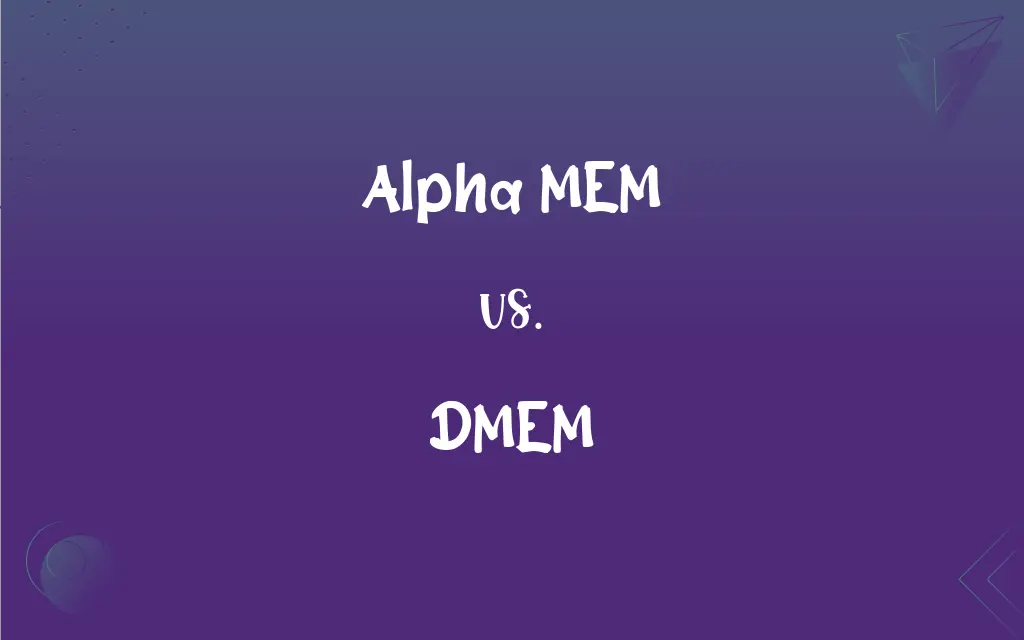Alpha MEM vs. DMEM: What's the Difference?
Edited by Harlon Moss || By Janet White || Published on February 1, 2024
Alpha MEM is a specialized medium for mammalian cell culture, enriched with amino acids and vitamins, while DMEM is a more general, nutrient-rich medium, suitable for a broader range of cells.

Key Differences
Alpha MEM (Minimum Essential Medium Alpha) is a cell culture medium designed to support a wide variety of mammalian cells, offering a unique formulation enriched with amino acids, vitamins, and other essential nutrients. In contrast, DMEM (Dulbecco's Modified Eagle Medium) is another popular cell culture medium, known for its high glucose content and ability to support the growth of embryonic and other demanding cell types.
Alpha MEM is particularly beneficial for cells that require a more complex nutritional environment, as it includes non-essential amino acids and other supplements that support specialized cell types. DMEM, on the other hand, is often used for fast-growing or high-density cell cultures, due to its higher concentration of nutrients and vitamins.
The formulation of Alpha MEM can be modified with additional supplements like nucleosides or hormones, catering to specific cell types or research needs. DMEM's versatility lies in its adaptability to various cell lines, including mammalian cells, and can be supplemented with fetal bovine serum, antibiotics, or other additives.
Alpha MEM's unique composition makes it ideal for studies in cell differentiation and nutrition-related research. DMEM, with its robust and versatile formulation, is a staple in many cellular biology labs for applications ranging from cancer research to gene expression studies.
Both Alpha MEM and DMEM are essential tools in cell culture, their specific compositions and applications cater to different research needs and cell types, highlighting the importance of choosing the right medium for specific experimental objectives.
ADVERTISEMENT
Comparison Chart
Primary Use
Supports a variety of mammalian cells
Ideal for embryonic and demanding cells
Nutrient Composition
Enriched with amino acids and vitamins
High in glucose, vitamins, and nutrients
Adaptability
Customizable for specific cell types
Versatile for a wide range of cell lines
Research Application
Cell differentiation, nutrition studies
Cancer research, gene expression studies
Nutrient Specificity
Includes non-essential amino acids
Higher concentration of essential nutrients
ADVERTISEMENT
Alpha MEM and DMEM Definitions
Alpha MEM
Alpha MEM is a nutrient-rich medium for mammalian cell culture.
Our lab uses Alpha MEM for culturing specialized neuronal cells.
DMEM
DMEM contains a higher concentration of essential nutrients.
The nutrient-rich DMEM facilitated rapid cell division.
Alpha MEM
It is known for supporting various cell types with its enriched formula.
The diverse cell types thrived in the Alpha MEM environment.
DMEM
DMEM is a high-glucose, nutrient-rich medium for cell culture.
Our embryonic cells are cultured successfully in DMEM.
Alpha MEM
Alpha MEM includes non-essential amino acids and vitamins.
Alpha MEM's amino acids are crucial for our tissue regeneration studies.
DMEM
It's widely used in biological research like cancer and gene studies.
Our gene expression research relies heavily on DMEM.
Alpha MEM
It's often used in cell differentiation and nutrition research.
For our differentiation experiments, Alpha MEM provided the necessary environment.
DMEM
DMEM is adaptable, often supplemented for specific cell needs.
We added fetal bovine serum to the DMEM for better cell growth.
Alpha MEM
Alpha MEM can be customized with supplements for specific needs.
We added nucleosides to the Alpha MEM to support our cell culture.
DMEM
It supports a broad range of mammalian cell types.
DMEM proved versatile for both our cancer and skin cell cultures.
FAQs
Can Alpha MEM be customized?
Yes, Alpha MEM can be supplemented with additional nutrients for specific cell types.
What is DMEM?
DMEM is a versatile, nutrient-rich medium used for culturing a wide range of mammalian cells.
What research uses Alpha MEM?
Alpha MEM is used in cell differentiation and nutrition-related research.
Can DMEM support specialized cell types?
Yes, with supplementation, DMEM can support various specialized cell types.
What makes DMEM different from Alpha MEM?
DMEM has a higher glucose content and is more generalized, suitable for a broader range of cells.
Is DMEM good for embryonic cell cultures?
Yes, DMEM's nutrient-rich composition makes it ideal for embryonic and demanding cell types.
How do you supplement Alpha MEM for specific needs?
Alpha MEM can be supplemented with hormones, nucleosides, or other additives.
What additives are commonly used with DMEM?
Common additives for DMEM include fetal bovine serum, antibiotics, and specific growth factors.
What is Alpha MEM?
Alpha MEM is a specialized medium for mammalian cell culture with enriched nutrients.
What cells are best cultured in Alpha MEM?
Alpha MEM is ideal for various mammalian cells, especially those requiring complex nutrients.
Is Alpha MEM suitable for high-density cell cultures?
It can be used, but DMEM is often preferred for high-density cultures due to its nutrient profile.
Is Alpha MEM suitable for gene expression studies?
While possible, DMEM is more commonly used for such studies due to its robustness.
Can both media be used interchangeably?
While similar, they have specific formulations for different needs and aren't always interchangeable.
What are the main applications of DMEM?
DMEM is widely used in cancer research, gene expression studies, and other biological research.
Is Alpha MEM more expensive than DMEM?
The cost can vary, but specialized media like Alpha MEM may be more expensive due to its enriched components.
Can Alpha MEM be used for cancer research?
It can be used, but DMEM is often preferred for its adaptability in cancer research.
What kind of supplementation does DMEM require for embryonic cells?
For embryonic cells, DMEM may be supplemented with specific growth factors and serum.
Are there any cells that cannot be cultured in Alpha MEM or DMEM?
Some highly specialized cells may require more specific media formulations.
How is DMEM adapted for high-density cell cultures?
DMEM's high nutrient concentration naturally supports high-density cell growth.
Can both Alpha MEM and DMEM be stored similarly?
Yes, both should be stored as per manufacturer guidelines, usually at 2-8°C and away from light.
About Author
Written by
Janet WhiteJanet White has been an esteemed writer and blogger for Difference Wiki. Holding a Master's degree in Science and Medical Journalism from the prestigious Boston University, she has consistently demonstrated her expertise and passion for her field. When she's not immersed in her work, Janet relishes her time exercising, delving into a good book, and cherishing moments with friends and family.
Edited by
Harlon MossHarlon is a seasoned quality moderator and accomplished content writer for Difference Wiki. An alumnus of the prestigious University of California, he earned his degree in Computer Science. Leveraging his academic background, Harlon brings a meticulous and informed perspective to his work, ensuring content accuracy and excellence.































































